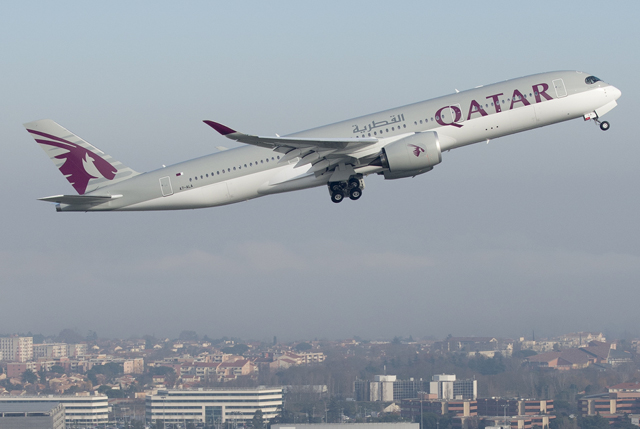As Airbus ramps up output, it is first-tier suppliers such as Latecoere that must get the balance right between capital investment and meeting the tight delivery demands of its biggest customer. This dilemma can be seen at Latecoere’s main facility in Toulouse, where two giant riveting machines have been newly installed to join the seven Korean-made metal panels that make up the A330’s fuselage section 15.
The production hall has been doubled in size to meet a monthly production rate of 10 aircraft. But production of the mid-range twin-aisle airliner is likely to fall to rate six or below from next year, before slowly recovering as deliveries of its A330neo successor pick up towards the end of the decade. Latecore will produce its first A330neo section in the middle of next year, but not before monthly output of the structure almost halves from its current rate.
The relationship with Europe’s big airframer has been lucrative for Latecoere – Airbus accounts for up to 57% of its revenues, depending on the year. However, the production ups and downs of individual programmes prompted the French company to diversify its business beyond Europe around a decade ago, securing valuable contacts with Boeing and Embraer on the 787 and E-Jets programmes, respectively.

Latecoere is a major supplier of structures for the Airbus A350
Airbus
Since the 1980s, aircraft doors have been one of Latecoere’s specialities – it makes them for the A380, A320 and E-Jets, among others. But the Dreamliner’s are its only composite ones. The company has been a risk-sharing programme participant on the 787 since the start. It is also developing a new overwing door for the latest E-Jet family, the E2, because of a new wing design. It already supplies six doors on each of the current range of Brazilian regional jets.
“We are a lot more diversified today than we were 10 years ago,” says Hervé Schembri, senior vice-president of marketing and strategy. With turnover in 2014 of around $737 million, “we are a smaller tier-one than Stelia [Aerospace, the Airbus Group-owned combined Sogerma and Aerolia business], Premium Aerotec [also Airbus-owned], Spirit [AeroSystems] and Triumph”, he says. “But we are probably more diversified.”
Latecoere also has a connection systems – or wiring – business, Latelec, making up 28% of its revenues (machine tooling for third parties represents the remainder). It entered the wiring business in the 1980s with the launch of the A330, and today its contracts include wing and cockpit wiring harnesses for the A350. Because the activity is labour-intensive, like all its rivals it outsources much of the work to low-cost countries – particularly its facility in Tunisia, which opened in 1998.
For a company such as Latecoere, managing its own supply chain – both its own overseas factories and to a greater extent its build-to-print third-party suppliers – is the most challenging aspect of meeting the demands of its customers’ ramp-up schedules. “We want to help them to grow in terms of quality and on-time delivery and to move towards managing their own material supply,” says Schembri. “Five years ago we provided their materials.”
The production schedules of various programmes see demands for Latecoere’s products shift from year to year. “For the 787, the big wave was more last year,” says Schembri. “For the A320, the second wave will be at the end of this year and next year.” With a series of contracts for structures and electrical products, Airbus’s latest widebody is fast becoming the company’s most important programme. “On the A350 we are fighting [to increase production] every day,” he says.
Latecoere’s 1930s-era Toulouse plant, deep within the city itself, seems incongruous with its surroundings. Old buildings and chimneys – part of a former brickworks – form part of the site and cannot be demolished by law, while modern apartment and office blocks surround the factory, making the exit of the heavy-load trucks that transport large sections to Airbus and other customer facilities tricky at times. “We were here first and the city has grown around us,” explains Schembri.
That said, he insists Toulouse is “a good place to be in terms of sourcing talent and being next to our main customer”. Latecoere’s policy is to have design and development functions in France, together with final assembly, as well as industrialisation and tooling after new programmes are launched. It also has an aerostructures site in Gimont, 40km (25 miles) west of Toulouse. “When programmes become mature, we look to move manufacturing to lower-cost regions,” says Schembri.
One of these is the Czech Republic, where Latecoere set up a factory in 2000 that now employs 800 people. The facility is a centre of excellence for doors, producing them for the A320, A380 and E-Jets, while also carrying out some of the work on the composite 787 door. The company also has a site near Embraer in Brazil, and in 2014 established a plant in the Mexican border state of Sonora to serve Boeing, where it will be producing five 787 shipsets a month by the end of the year.
Business aviation could be another opportunity for Latecoere – which was founded in 1917 and built its own aircraft until the 1950s. So far, the company’s only significant contracts in the market have been with Dassault, for which it builds doors and fuselage sections for the Falcon 7X and 8X. However, Schembri hints: “Business aviation is part of what we are developing for the future. You will see an announcement very soon.”
Source: Flight International
















